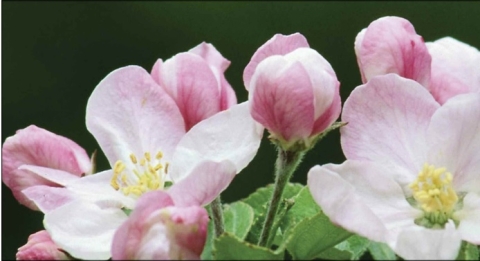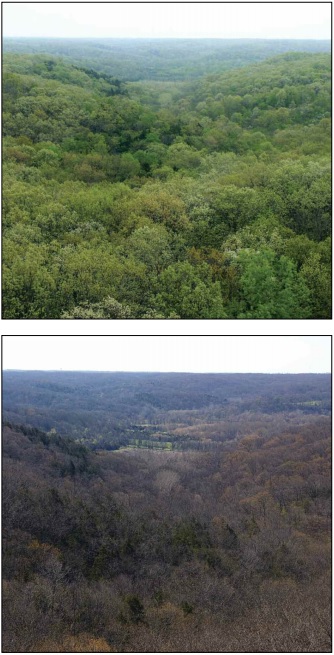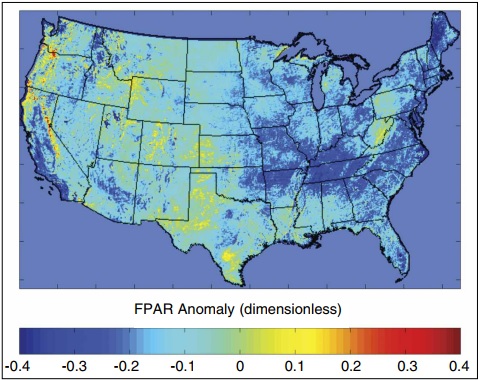In March 2007, the eastern United States enjoyed soaring temperatures and an early spring. Plant ecologist and Oak Ridge, Tennessee, resident Lianhong Gu was among those who noted both the warmth and the plants bursting into growth. He said, “I was enjoying the green outside my office window and watching the plants in my garden at home to see when the buds broke.” For over a week, temperatures in parts of the eastern United States rose as much as 15 degrees Celsius (27 degrees Fahrenheit) above normal, a sharp spike in thirty years of temperature records.
Despite his appreciation for the early arrival of spring, Gu saw a potential downside. “Plant ecologists know that if temperatures in the early spring are high, then plants may start premature development,” he said. “That means tender tissues and organs may be exposed to subsequent frosts, potentially affecting productivity for the whole year.” And, scientists like Gu believe that the cycle of early spring warming, premature plant growth, damage from freezes, and subsequent decline will increase with the unpredictable temperature fluctuations expected as climate change takes hold.
In early April, as Gu watched the evening news, he heard the forecaster describe a cold arm of Arctic air throwing itself over the eastern United States. A cycle of extremes was about to unfold in real time. He said, “I knew the vegetation and crops were going to suffer greatly.” Gu, a scientist at NASA's Oak Ridge National Laboratory Distributed Active Archive Center (ORNL DAAC) contacted friends and colleagues so that they could help document the freeze with ground observations. “We kept driving around eastern Tennessee and northern Georgia, photographing damaged trees and crops everywhere,” he said. Gu next marshaled a range of data from NASA satellites and ground networks to study the Easter Freeze of 2007, as it came to be called. The efforts of Gu and his colleagues will help make clear the challenges that plants and people face as we adapt to the stresses of a warming world.
The Easter Freeze of 2007
According to a United States Department of Agriculture (USDA) report, 2007 experienced the second-warmest March on record for the entire United States. Plants broke their winter dormancy and geared up for the growing season much earlier than normal. For example, the USDA found that in Tennessee, 62 percent of the apple trees were in bloom or in even later stages of growth in March, compared to an average of 42 percent at the same time during the last five years.
Then the temperature dropped. In early April, the Arctic air that had gripped Alaska in its third-coldest March on record swept down over the central and eastern United States. Temperatures in some locations plummeted into the teens overnight. Gu said, “The freeze came and the plants drooped miserably—we saw tremendous damage all over the region.”
The USDA reported that four to five nights of sub-freezing temperatures broke 1,237 daily minimum temperature records and tied another 321 records, causing $2 billion in crop damage. Gu compared the date of the freeze to the long-term record of last frost dates, using temperature data obtained from the National Climatic Data Center in Asheville, North Carolina, and from two ground-based flux tower observational sites, one in Tennessee and one in Missouri. The flux towers are part of the AmeriFlux regional network and the global FLUXNET network of tower-mounted sensors. FLUXNET is a key activity of ORNL DAAC. Gu found that over the past three to five decades, the date of the last frost normally arrived between day 80 and 120 at the Tennessee site and somewhat later at the Missouri site. He said, “The April 2007 frost arrived around day 95. At first glance, it might seem that the freeze, although record-breaking in terms of temperature, was not that unusual in its timing. Why was the freeze so devastating?”
The data confirmed a twist that farmers and gardeners have long known intuitively. The data from Gu and his collaborators documented that the late record-breaking freeze was actually not to blame for the withered plants. “If the temperature is low, new leaves and flowers won’t form and the plants will be okay if a freeze comes. But if the temperature is high and plants have already started the growing process, then a freeze will cause extensive damage,” Gu said. So the Easter Freeze of 2007 was, in a way, innocent; more at fault was the preceding period of early warm temperatures that coaxed the plants out of dormancy and into harm’s way. “Timing is very important for plants as they break dormancy,” Gu said. “And while unusual warm-cold patterns like these have always occurred occasionally, global warming may make them more frequent and more severe—and that could be stressful for plants.”
Seeing devastation in the leaves
To measure the degree of ongoing disruption to plants, Gu also used remote sensing data from the Moderate Resolution Imaging Spectroradiometer (MODIS) instrument, aboard NASA's Terra and Aqua satellites. Gu and his collaborators relied on the MODIS Fraction of Photosynthetically Active Radiation Absorbed by Vegetation (FPAR) product, archived at NASA's Land Processes DAAC (LP DAAC), to show them where plant photosynthesis declined after the freeze. “After the April freeze, the green was gone and growth had fallen far behind that of an average year,” Gu said.
The flux tower data also included information on the exchange, or transpiration, of water vapor between the vegetation at the two sites and the atmosphere above them. “Because the freeze damaged leaves, the transpiration stream was stopped,” Gu said. “You’re not just talking about growth stopping as a response to freezing temperatures, but because of physical and physiological damage.” In other words, the data were not simply indicating that the plants had shut down for a while to wait out the cold; it meant that the plants were physically damaged and could not grow.
The damage caused by the early growth and late freeze turns around the key point of plant dormancy ending, and growth beginning—the crucial time of transition that spring represents in making or breaking a plant’s survival. “Timing is very important to whether plants make it or die,” Gu said. “Any environmental factor that affects the timing of plant growth can have serious consequences for plant productivity for the long term.” Plants need to experience a set period of temperatures below a certain threshold to enter and maintain dormancy, and a set period of rising temperatures to break dormancy and begin growing. “It’s almost like double insurance,” Gu said. “Plants are smart. Their reactions have been established based on past climate conditions. That’s why this topic is interesting in terms of climate change. If we artificially change the climate conditions so past experiences don’t apply anymore, then plants have trouble.”
Piling stress on plants
One of the noteworthy findings that Gu and his collaborators unearthed during their work on the Easter Freeze of 2007 was that some plants did fare better than others during the flip-flopping temperature pattern. “Some plants were damaged, and others were okay,” Gu said. “So why was there such a difference? It appears that native species were able to survive even the harsh conditions of spring 2007, but introduced species suffered much more.”
Gu believes that the native species are hardier because, over the ages, they have been exposed to the extremes of their particular locales more frequently. Although the conditions of 2007 broke records, past experience would have helped inform native plants in timing their break from dormancy. Conditions weeded out plants that did not time their growth well, while those with better timing survived and multiplied. But with climate change taking hold, extreme temperature patterns may become more common; even past experience will not be enough to protect plants. “With warming of the climate, the warm-cold sequence might increase in frequency, and that would be stressful on plants, even on native species,” Gu said.
Plants have solid strategies for dealing with stresses like temperature fluctuations, but these strategies cost energy. “To tolerate stressful conditions, plants have to use energy. They have to transform some of the carbon and nutrient reserves in their bodies to increase certain chemicals that allow them to resist the stressful condition and to replace damaged tissues and organs,” Gu said. “But if they are not healthy, they won’t have enough of these reserves. If a plant is already in bad shape because of freezing conditions or other stresses, it will have trouble surviving the next stress, whether it’s drought or heat or flood.” So in a warming world, the stresses on plants could pile up, leading to long-term damage. Eventually, the damage could impinge on some plant species’ ability to survive in affected regions.
“Sometimes people think that we can take advantage of climate change—the increased length of the growing season, more mild temperatures,” Gu said. “They think we can plant new crops that would normally only grow further south. But there’s a risk there. Because as the 2007 freeze shows, in a warming climate the risk of severe freeze damage may actually be greater—and hit introduced species even harder.”
Gu and his colleagues hope to better understand that risk by studying the long-term effects of the Easter Freeze of 2007. Central to their work is the need for continued data streaming from FLUXNET and other long-term data sets. “The frequency of extreme events may not be high, but once they occur, they are more damaging in the long term. And you can’t plan for them. Freezing, heat, drought—these events aren’t predictable,” Gu said. “We need steady long-term observations and then when an extreme event occurs, we have the data to study it, anticipate the consequences, and plan for the future.
References
Gu, L., P. J. Hanson, W. Mac Post, D. P. Kaiser, B. Yang, R. Nemani, S. G. Pallardy, T. Meyers. 2008. The 2007 eastern U.S. spring freeze: Increased cold damage in a warming world? BioScience 58 (3): 253-262, doi:10.1641/B580311.
The Easter Freeze of April 2007: A climatological perspective and assessment of impacts and services. NOAA/USDA Technical Report 2008-01. http://www1.ncdc.noaa.gov/pub/data/techrpts/ tr200801/Easter Freeze_revised April 28.pdf
For more information
NASA Land Processes Distributed Active Archive Center (LP DAAC)
NASA Oak Ridge National Laboratory DAAC (ORNL DAAC)
| About the data | ||
|---|---|---|
| Satellites | Terra and Aqua | |
| Sensors | Micrometeorological sensor data from AmeriFlux and FLUXNET | Moderate Resolution Imaging Spectroradiometer (MODIS) |
| Data sets | Walker Branch and Missouri Ozark flux tower sites | 1 kilometer Fraction of Photosynthetically Active Radiation Absorbed by Vegetation (FPAR) |
| Resolution | 8 kilometer | |
| Parameters | Temperature, water vapor, sensible heat, radiation flux for Normalized Difference Vegetation Index (NDVI) |
FPAR |
| DAACs | NASA Oak Ridge National Laboratory Distributed Active Archive Center (ORNL DAAC) | NASA Land Processes DAAC (LP DAAC) |


